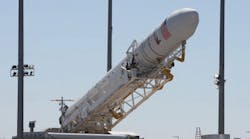WASHINGTON -- Paving the way for a demonstration flight to the International Space Station within months, Orbital Sciences (IW 500/461) launched its first Antares rocket Sunday.
The two-stage launch vehicle blasted off at 5:00 pm from the Wallops Flight Facility on an island off the coast of the eastern US state of Virginia.
As this was a test mission, Antares was not transporting the company's Cygnus capsule but rather a simulation of an equivalent payload of 3.8 tons -- filled with electronic equipment -- placed into orbit at an altitude of roughly 160 miles 10 minutes after takeoff.
The control room erupted in applause after the simulation payload separated from the rocket, a vehicle measuring 131 feet tall and 12.8 feet in diameter.
"Congratulations to Orbital Sciences and the NASA team that worked alongside them for the picture-perfect launch of the Antares rocket," NASA Administrator Charles Bolden said.
"In addition to providing further evidence that our strategic space exploration plan is moving forward, this test also inaugurates America's newest spaceport capable of launching to the space station, opening up additional opportunities for commercial and government users."
With the launch a success, Virginia-based Orbital Sciences now plans a demonstration run to the space station with the Cygnus capsule in three months, followed by its first delivery mission before the end of the year.
"Today marked a giant step forward for the Antares program, with a fully successful inaugural flight of the largest and most complex rocket the company has ever developed and flown," said Orbital chairman David Thompson.
"We will now move forward toward completing the full demonstration mission of our system to resupply the International Space Station with essential cargo in just a couple of months."
A $1.9 billion contract requires Orbital Sciences to deliver freight to the ISS over the course of eight flights by the beginning of 2016. It is one of two private U.S. firms chosen by NASA to shuttle cargo to the outpost.
Unlike the Dragon capsule developed by rival SpaceX, Cygnus cannot return to Earth and will be destroyed upon re-entry after its mission is complete.
However, Orbital Sciences said Cygnus could stay in orbit for up to a year, while the simulated payload will do so for two weeks.
SpaceX made history when Dragon became the first commercial spacecraft in history to successfully attach to the International Space Station in a May 2012 test flight.
Dragon has already successfully completed three missions to the space station and must complete another ten to fulfill California-based SpaceX's $1.6 billion contract.
NASA retired its fleet of space shuttles in July 2011 and has been relying on Russia's Soyuz spacecraft to transport its astronauts to the ISS at a cost of $63 million a seat.
US cargo was being transported to the ISS by European, Japanese and Russian shuttles which, like Cygnus, cannot return to Earth and are destroyed upon re-entry.
SpaceX, Boeing and Sierra Nevada have also been retained by NASA to develop ships to transport astronauts to the ISS and other destinations.
The Antares rocket launch had been planned for Wednesday but was called off 12 minutes before the firing up of the engines due to a minor technical problem. An attempt set for Saturday was scrapped due to strong wind.
- Jean-Louis Santini, AFP
Copyright Agence France-Presse, 2013



